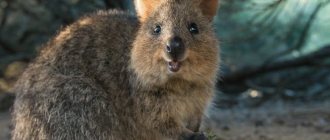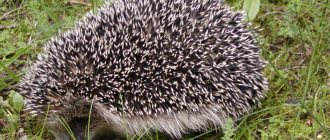Swallows are small birds that belong to the family of swallows in the passerine order. Their difference from other passerine birds is their long wings and tails. The swallow has a wide chest, short neck and flat head. The beak is short, flat, widening towards the base, almost triangular, with a slightly bent end.
The legs are short, weak and with tiny claws. The feathers are short, tightly adjacent to each other, with a characteristic metallic sheen. Female and male individuals differ little in plumage color. On the contrary, chicks in the first days of life are very different in color from adults.
Swallow habitat
Habitat of swallows
Swallows live in almost all regions. For hot countries these are sedentary birds, for the northern regions these are migratory swallows. When frost sets in, the bird flies to warmer regions and returns back in the spring. Usually swallows try to return to their nests from last year. And if these are young birds, then they will certainly begin to build a family nest.
Dive
Ninth place in the rating for the dive. This bird is also a duck and lives throughout almost all of Eurasia. Compared to other ducks, pochards are quite large, weighing up to 1.5 kg, and can reach half a meter in length.
A distinctive feature of male pochards is their red-brown head.
Pochards are peaceful birds and feed only on plant matter. They are distinguished by their elegant colors and high flight speed - up to 115 km/h.
Dives reach speeds of up to 115 km/h
How many types of swallows are there and where do they live?
Types of Swallows
There are 79 species of swallows. A large number of swallows find shelter in people's houses, some settle on rocks and cliffs, and swallows also choose trees to make nests.
Most species have adapted to build strong nests; the outside walls are made of clay lumps soaked in sticky saliva. Some species, with great difficulty, dig holes in the soil of earthen cliffs, make an extension at the end and build a nest there; most nests consist of a large number of feathers folded in a heap. A clutch usually contains 3-5 eggs, which are incubated only by the female.
Martin
Swallows are usually called noble birds, since they are beautifully gifted in a physiological and aesthetic sense. These birds spend the bulk of their lives in flight. They rest in trees, sitting on branches and twigs without leaves, so that they can easily fly in and fly away.
Swallows are songbirds. They are very understanding and smart. Arriving at a new area, they carefully study it. Swallows have learned to distinguish friends from enemies and will only trust those who earn their trust.
Martin
A small and very beautiful bird nests under the roof of a house. This swallow has chosen your house. Since childhood, everyone has been familiar with this bird, which personifies hope, fidelity and rebirth.
Interesting: Great Horned Owl - interesting facts
People have a particularly reverent and warm attitude towards the swallow. It’s not for nothing that a good-natured and sympathetic person is called a “swallow.”
Natural enemies
Swallows are birds with excellent flight characteristics, so they are much more likely to avoid dangerous encounters with various predators. Of particular danger to them is the hobby falcon, which is characterized as a fast and agile predator that is capable of attacking swallows in the air.
Important point! Swallows become vulnerable to their enemies during the period of nest construction, when they fly up to bodies of water to find building material.
Where do swallows build their nests?
Swallow's nest
Some species of swallows have become so accustomed to people that they build their nests closer to people. However, birds prefer villages rather than big cities. In rural settlements, swallows predominantly choose small but fairly open formations. Stables, sheds, all kinds of terraces, etc. are suitable for building nests for birds. But their favorite place remains the roof of the house.
Swallow nests can also be found in the wild. Birds settle in the desert or vast steppe. But this happens provided that there are no suitable places for construction nearby. Swallow nests are also found under the ceilings of grottoes, under large tree branches, and even under large nests of feathered predators.
Swallow's nest
Swallows are considered skilled builders. They build nests from lumps of wet soil. Birds find wet soil on the banks of lakes and rivers. City swallows collect dirt in puddles. Having found wet soil, the bird rolls it into a ball with its beak. Wet round lumps are firmly attached to the wall. For gluing, the swallow uses its own saliva.
Blades of grass, thin twigs, horsehair and other similar materials are laid out between the balls. The finished nest is covered inside with down and soft blades of grass. The swallow house shape resembles a deep cup. Both the male and the female are involved in nest construction.
Only after the completion of construction does the romantic period of mating begin. Males tell the female about their love with pleasant chirping. And she, in turn, meekly accepts his proposal. Swallows are considered monogamous birds. A couple is created once and forever.
General information
The swallow is a very graceful bird . It is distinguished by black plumage with a beautiful blue tint on the back. The abdomen and lower part of the wings are yellow or white, the head is slightly flattened, and the beak is small. Elongated, narrow, long wings and a tail with a slit give swallows special grace. The male and female are like two peas in a pod and have virtually no differences. This significantly distinguishes them from most birds, in which the male usually has brighter and more beautiful plumage than the female.
Swallows are quite miniature birds, their length ranges from 9 to 24 cm . The weight of the largest representatives reaches 25 and 60 grams , the smallest individuals weigh only 10 grams .
Chicks
Swallow chicks
Birds form their family in early spring. The female incubates an average of five tiny eggs per clutch. The chicks hatch within three weeks. Babies are defenseless and not at all adapted to the environment. That’s why parental care is so important to them. The only activity of the emerging chicks is to open their beaks wide and demand food.
From dawn to dusk, parents hunt various insects. Thanks to caring adults, the chicks grow at an unprecedented rate. Well-fed little swallows take their first flight in less than a month. Despite the fact that the chicks have grown up, the parent swallows continue to feed them. Their diet includes all kinds of bugs, flies and even butterflies.
Grey-headed albatross
Grey-headed albatrosses are also very fast birds. They live on islands near Antarctica. Most of the time, these birds soar over the ocean, hunting for fish, squid and other aquatic life.
Grey-headed albatrosses live in the Southern Hemisphere
Grey-headed albatrosses can fly very long distances, reaching speeds of up to 150 km/h. In addition, they can dive to depths of up to 7 m.
Grey-headed albatrosses spend most of their lives in the open ocean.
Features of swallows
The swallow catches insects.
One feature helps adults feed their offspring well. The fact is that swallows catch insects on the fly. This greatly reduces the time it takes to search for food. Thanks to this property, birds destroy a large number of harmful insects. People appreciate swallows for this, because where there are swallows, there is a good harvest.
Interesting: Bowerbird nests: photos and videos
These nimble birds not only get food for themselves on the fly, but also eat and even sleep. It’s beautiful to watch how swallows rush headlong over a pond, capturing water with their beaks in flight. Swallows spend almost most of their lives soaring in the air. They rarely fall to the ground, since they are almost not adapted to move on the surface.
Despite their tiny size, swallows are very hardy and have great endurance. They are capable of flying great distances. Long flights require unprecedented strength and patience. After all, migration is always fraught with all sorts of dangers and difficulties.
Nutrition
The main dish is flying insects. The bird grabs them in the air at a height of 15-20 meters above the ground. When it rains, swallows do not go out hunting, but wait. Birds try not to fly far from the nest while searching for food. All work to catch flies, bugs and other insects is usually carried out within a radius of up to 500 meters from the nesting site.
Insects included in the diet: grasshoppers, flies, butterflies, cicadas, moths, horseflies, mosquitoes, beetles, and sometimes spiders. Wasps and bees are not included in the diet, because they are poisonous to birds.
What is the difference between a city swallow and a village swallow?
Anyone who likes to watch swallows fly has probably noticed the difference between them. Indeed, in nature there are several species of these fast-winged birds. Many people know that there are city, village and coastal swallows. They have both differences and similarities.
Swallows: coastal, village, city
The city swallow, also known as the swallow, has a slightly shorter tail than its relative. A distinctive feature of this genus is its blue-black back and white breast. Barn swallows have a long forked tail. The forehead and throat are full of reddish plumage. They look quite larger than the city ones. They like to affectionately call the village bird a killer whale. The killer whale also differs from the funnel by the sharp tips of its wings and a fairly wide beak. Pointed wings allow killer whales to demonstrate masterly flight.
Golden eagle
The next fastest is the golden eagle from the hawk family. It is much larger than the peregrine falcon - up to 95 cm in length. The wingspan of the golden eagle reaches 2–2.5 meters.
Golden eagles are dangerous predators for farm animals
With a hooked beak, powerful talons and a furrow above the eyebrows that give the bird a rugged appearance, the golden eagle is the epitome of a winged predator. And appearances are not deceiving, because not only small animals, but even calves and young deer become his prey. Like the peregrine falcon, the golden eagle develops its maximum speed when lunging at its prey. It can reach 320 km/h.
The speed of the golden eagle is slightly inferior to the speed of the peregrine falcon
Signs associated with swallows
For example, if swallows arrived in early spring, it means there will be a good grain harvest in the fall, but if they arrive late, you may not expect a generous harvest. Before the rain, these birds begin to fly low above the surface of the earth. And before a clear and warm day, you can hear their cheerful and sonorous chirping.
Swallow before the rain
A flock of swallows has always been considered a very auspicious sign. If you notice a flock rushing overhead, it means good luck to you. If swallows scurry around your house, expect good luck. And if a flock flies over the lovers, then great mutual love awaits the couple.
Gaga
And again in the rating is a duck, but this time a sea duck. Eiders live in northern America and Eurasia. They are very large, weighing up to 3 kg, up to 80 cm long.
Eiderdown is highly valued by people
Clumsy on land, the eider is an excellent swimmer and flier, reaching speeds of up to 90 km/h.
The female eider looks like an ordinary duck
Eiders dive the deepest of all birds on Earth - up to 50 m deep.
Swallows' vision
Swallow
The swallow has very good eyesight. She perfectly sees a tiny insect in flight at a distance and pursues it, orienting herself only with her eyes. The barn swallow sets up a nest in a building so that it is covered from above with a roof. It happens that large companies settle in such places. The nest looks like a quarter of an empty ball. On average, it takes one pair eight days to build a nest. Stems, hair, feathers and other soft materials are spread inside the nest. A swallow's nest can last for several years and for subsequent generations.
Interesting: Why don't some birds fly south? List, reasons, description, photos and videos
Spur goose
Spur geese live in Africa near bodies of water. These are quite large birds that can reach 1 m in length and weigh more than 6 kg.
Spur-tailed geese feed mainly on fish
Well-developed wings and legs help this goose to fly and run quickly. Its flight speed reaches 140 km/h.
Spur goose is a large bird
Sometimes the spur goose is called poisonous. In fact, its meat can be poisonous only if the bird ate toxic insects.
Barn Swallow
The barn swallow's
upper body and crop are dark blue, with a metallic tint. The throat and forehead are bright chestnut. The bottom is light yellowish in color. Females are distinguished by paler shades from males. Barn swallows are found throughout Europe, western and central Asia.
This species of swallow has been accustomed to man and his home since ancient times. Her attachment to a human home led to our love for her, and in the northern countries people were taught to consider the arrival of a swallow as the beginning of spring, and the departure as the beginning of dull autumn.
City swallow
City Swallow
The entire body of the city swallow is covered with blue-black feathers, only the tail is white below. The eyes are brown, the beak is almost black. The chicks have black plumage. The city swallow is found almost in the same place as the village swallow and also a little to the north. This species of swallow builds nests only on buildings, with protection from the rain on top. The shape of the nest resembles that of a barn swallow. Nest construction lasts 10-15 days.
Beregovushka
Shore Swallow and Nest
The feathers on top are earthy-brown in color; below - white with a brown-ash stripe on the chest. The shorebird is common in most areas; it settles mainly on steep banks. With great effort, they dig deep holes for nests in the dense earth, most often along the top of a slope, so that water does not flood them.
Thread-tailed Swallow
Thread-tailed Swallow
The wings are narrow and long, the tail is long and fork-shaped. The beak is short and triangular in shape. The legs are short and weak, but with tenacious claws. Thanks to which swallows cling to walls and steep cliffs. The top of the body is dark, with a blue tint, and the bottom is light.
Swallows are monogamous birds; partners remain faithful to each other for one season. In the northern regions, swallows make one clutch per year, in the southern regions - 2 clutches.
Swallows are quite stable and can withstand various loads well. These birds bring great benefits to humans by exterminating small insects that other birds do not eat - mosquitoes and flies.
Hobby
A relative of the peregrine falcon is the hobby. It also belongs to the falcon family. Hobbies live throughout Eurasia and North Africa. Outwardly, it is similar to the fastest bird in the world, but smaller - up to 36 cm in length. The hobby eats small birds and animals, large insects. Interestingly, it can eat prey that is three times its size.
Externally, the Hobby looks like a peregrine falcon
During hunting, the speed of the Hobby can reach 250 km/h, although the rest of the time it flies a maximum of 160 km/h.
The Hobby develops its maximum speed in a hunting throw
Common kestrel – km/h
The distribution area is Central Europe, where there are flat terrain. A distant relative of the peregrine falcon, when hunting, it falls on top of rodents. Prefers to fly leisurely or replaces fast flight with gliding. Sometimes it soars, hovering in the sky, making frequent “vibrating” flapping of its wings. If necessary, folds them or does not fully open them, and is able to move unconsciously.
Falcon
The diving flight of these birds is amazing. They are widespread, found on all continents. Medium-sized individuals with a transitional plumage color from light gray to black. Representatives of the falcon family have narrow wedge-shaped wings, due to which they deftly maneuver. Travel speed in the air is up to 350 km/h. Not every car in the 21st century can accelerate like that.
Falcon is a bird of prey. It hunts in flight, looking from above for prey. As soon as the target is identified, it quickly dives down and inflicts a powerful fatal blow on it with its paws. According to the method of hunting and morphological characteristics, the falcon family is divided into 4 ecological groups:
- Kestrels. They feed on small land animals and grab prey with their beaks. Average flight speed is 63 km/h.
- Hobbies, New Zealand, short-tailed and brown falcons. Representatives of this group hunt for small birds. Flight speed – 160 km/h.
- Peregrine falcons. They have developed muscles. They hunt medium-sized birds and ground mammals. Flight speed - 350 km/h.
- Gyrfalcon, lanner, saker falcon, laggar. These are the largest birds from the falcon family. They reach speeds during flight of up to 200 km/h. They feed on partridges, waders, gulls, and geese.
Bird flight speed table
Table 1. Distances covered during flights
| Bird | Return flight, km |
| Stork Short-tailed loon Song thrush Crane Cuckoo Arctic tern Starling | 10 000 17 500 2 600 6 500 9 500 20 000 1 400 |
Table 2. Wing surface area and load on them
| Bird | Wing area, dm2 | Wing load, kg/m2 |
| Stork Albatross Sparrow Raven Pigeon Black Thrush Ruby-throated Hummingbird Wren Eagle Griffon Vulture Black Swift Goshawk Silver Gull | 55,2 62,2 1,2 20,5 8,4 3,1 0,1 0,5 59,3 104,5 1,3 20,5 20,1 | 6,7 15,8 2,4 3,1 2,4 2,9 2,4 1,1 7,0 7,2 3,0 4,1 4,2 |
For comparison, the glider model has a wing load of 2.5 kg/m2.
Table 3. Wing flapping frequency
| Bird | Number of strokes in 1 s |
| Stork House Sparrow Pigeon Amethyst Hummingbird Mallard Pelican Peregrine Falcon Starling Owl Magpie Black Swift Silver Gull | 2 13 8 78 5 1,2 4,3 5,1 4 3 12 3 |
Table 4. Maximum flight speed
| Bird | Flight speed, km/h |
| Stork Albatross House Sparrow Ravens Homing Pigeon Gray Goose Kingfisher Mallard Falcon Swift Black Sparrowhawk | 45 70 45 59 80 91 58 104 79 180 58 |
This is interesting: How fast can a puma run?











